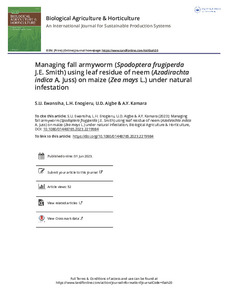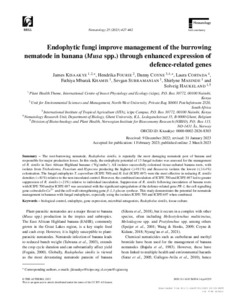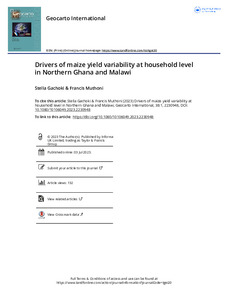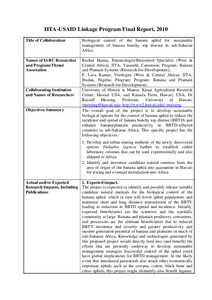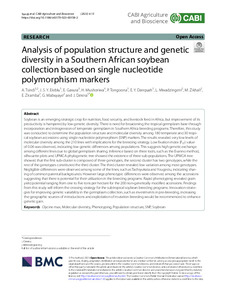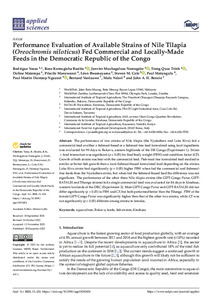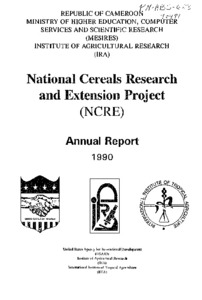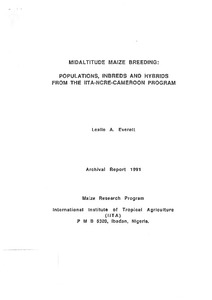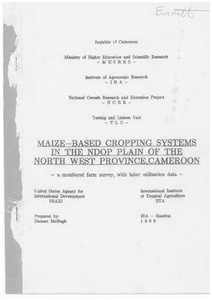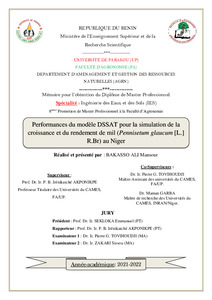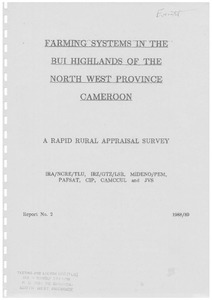Welcome to the International Institute of Tropical Agriculture Research Repository
IITA Bibliography System: Recent submissions
Now showing items 421-440 of 8094
-
Bioinoculants and organic soil amendments affect nematode diversity in apple orchards
(2023-10)Nematodes with their versatile lifestyles provide a suitable lens to decipher the conditions of agroecosystems, but less is known about how they are affected by bioinoculants and organic soil amendments. To test if treatments modify the nematode community, we studied nematode communities in two different apple orchards under organic and integrated farming. Soil was treated with products containing arbuscular mycorrhizal fungi, bioeffectors, and organic amendments. The comparison between baseline ... -
Managing fall armyworm (Spodoptera frugiperda J.E. Smith) using leaf residue of neem (Azadirachta indica A. Juss) on maize (Zea mays L.) under natural infestation
(2023-06-01)Fall armyworm (Spodoptera frugiperda J.E. Smith) is a pest that has established across sub-Saharan Africa, capable of causing 100% yield loss in maize. Although aqueous extracts of neem (Azadirachta indica A. Juss) are being used to manage this pest, neem leaf residue may have added beneficial effects. This investigation was conducted during April–November 2020 at the Training and Research Farm, University of Benin, Nigeria, aiming to improve maize yields by using neem leaf residue for managing ... -
Endophytic fungi improve management of the burrowing nematode in banana (Musa spp.) through enhanced expression of defence-related genes
(2023-03-02)The root-burrowing nematode, Radopholus similis, is reputedly the most damaging nematode pest of banana and responsible for major production losses. In this study, the endophytic potential of 13 fungal isolates was assessed for the management of R. similis in East African Highland bananas (‘Ng’ombe’). All isolates successfully colonised tissue-cultured banana roots, with isolates from Trichoderma, Fusarium and Hypocrea producing the highest (⩾49.1%) and Beauveria isolates the lowest (⩽14.4%) ... -
Biocontrol-based strategies for improving soil health and managing plant-parasitic nematodes in coffee production
(2023-06-20)Coffee is an important commodity for Kenya, where production is steadily declining, despite a global rise in demand. Of the various constraints affecting production, plant-parasitic nematodes are a significant, but often overlooked, threat. As a perennial crop, treating plantations once infected with nematodes becomes difficult. The current study evaluated the drenching application of two biocontrol agents, Trichoderma asperellum and Purpureocillium lilacinum, for their nematode control efficacy, ... -
Drivers of maize yield variability at household level in northern Ghana and Malawi
(2023-07-03)Maize is a staple food, but productivity has stagnated due to limited access to advanced farming methods and knowledge. To promote sustainable agriculture, understanding the factors affecting maize yield at the farm level is crucial. This study used panel data on maize yield and agronomic practices in Northern Ghana and Malawi from 2014 to 2020. Satellite-based environmental variables were extracted at household locations, and Random Forest modeling was used to identify factors influencing maize ... -
Closing the yield gap of soybean (Glycine max (L.) Merril) in southern Africa: a case of Malawi, Zambia, and Mozambique.
(2023-07-07)Introduction: Smallholder farmers in Sub-Saharan Africa (SSA) are increasingly producing soybean for food, feed, cash, and soil fertility improvement. Yet, the difference between the smallholder farmers’ yield and either the attainable in research fields or the potential from crop models is wide. Reasons for the yield gap include low to nonapplication of appropriate fertilizers and inoculants, late planting, low plant populations, recycling seeds, etc. Methods: Here, we reviewed the literature on ... -
Modelling the impacts of diverse cover crops on soil water and nitrogen and cash crop yields in a sub-tropical dryland
(2023-10-01)Understanding the implications of replacing fallows with cover crops on plant-available water (PAW) and soil mineral nitrogen (N) and their carry-over effects on subsequent cash crops is critical for understanding their potential for ecological intensification in water-limited environments. We modelled the impacts of different cover crop functional types over historical climate to predict how climate variability influences soil water and N acquisition and subsequent availability to a maize crop ... -
Biological control of the banana aphid for sustainable management of banana bunchy top disease in sub-Saharan Africa. IITA-USAID Linkage Program Final Technical Report; IITA project report
(IInternational Institute of Tropical Agriculture, 2010)This report presents the summary of the findings of a project on development of sustainable biological options for the control of banana aphid (Pentalonia nigronervosa) to reduce the incidence and spread of banana bunchy top virus (BBTV) and enhance banana/plantain productivity in BBTV-affected countries in sub-Saharan Africa. This specific project has the following objectives, (i) develop and refine rearing methods of the newly discovered species, Endaphis fugitiva, further to establish viable ... -
Analysis of population structure and genetic diversity in a Southern African soybean collection based on single nucleotide polymorphism markers
(2023)Soybean is an emerging strategic crop for nutrition, food security, and livestock feed in Africa, but improvement of its productivity is hampered by low genetic diversity. There is need for broadening the tropical germplasm base through incorporation and introgression of temperate germplasm in Southern Africa breeding programs. Therefore, this study was conducted to determine the population structure and molecular diversity among 180 temperate and 30 tropical soybean accessions using single ... -
Combining manure with mineral N fertilizer maintains maize yields: evidence from four long-term experiments in Kenya
(2023-02-01)Context Crop productivity in sub-Saharan Africa cannot be substantially improved without simultaneously addressing short-term crop nutrient demand and long-term soil fertility. Integrated soil fertility management tackles both by the combined application of mineral fertilizers and organic resource inputs but few studies examined its‘ long-term effectiveness. Objective To address this knowledge gap, this study analysed maize yield trends in four long-term (31–37 cropping seasons) field experiments ... -
Performance evaluation of available strains of Nile tilapia (Oreochromis niloticus) fed commercial and locally-made feeds in the Democratic Republic of the Congo
(2023)The performance of two strains of Nile tilapia (the Nyakabera and Lake Kivu) fed a commercial feed or either a fishmeal-based or a fishmeal-free feed formulated using local ingredients was evaluated for 99 days in Bukavu, eastern highlands of the DR Congo (Experiment 1). Strain × feed interaction was significant (p < 0.05) for final body weight (FBW) and condition factor (CF). Growth of both strains was best with the commercial feed. Fish-meal free formulated feed resulted in similar or better ... -
MESIRES, IRA and NCRE: Annual Report 1990
(USAID-IITA, 1991) -
Midaltitude maize breeding: populations, inbreds and hybrids from the IITA-NCRE-Cameroon program
(IInternational Institute of Tropical Agriculture, 1991) -
An agro-socioeconomic survey on farmers in the north-west province, Cameroon 1983
(United States Agency for International Development, 1983) -
Adaptive Research Programme: Technical Report No. 2
(North West Development Authority, Cameroon, 1986-12) -
Maize-based cropping systems in the Ndop plain of the north west province, Cameroon - a monitored farm survery, with labor utilization data
(United States Agency for International Development, 1988) -
Performance of DSSAT model for the simulation of millet (Pennisetum glaucum [L.] R.Br) growth and yield in Niger
(University of Parakou, 2022-11)Résumé Le mil (Pennisetum glaucum (L.) R. Br.) représente la principale céréale la plus utilisée et cultivée au Niger. Néanmoins, une baisse de production qui est due à plusieurs facteurs dont la pauvreté des sols et une inégale répartition de pluie dans le temps et dans l’espace. Cette dernière se traduit par un retard au niveau des installations des campagnes agricoles. Le choix de la date de semis et des variétés appropriées reste l’une des options pour faire face à ce problème. Cette étude a ... -
Farming systems survey of Meme division south west province Republic of Cameroon
(United States Agency for International Development, 1987)Background: In order to help IRA researchers on and off station direct their work more towards the potentials and needs of food-crop farmers in the South West and Littoral, the TLU at Ekona is undertaking a series of farming systems surveys. The series began in 1986. Objectives: To provide useful information to IRA breeders and agronomists, to MINAGRI extension workers and planners, and to the TLU for its on-farm trial program. Methods: Preliminary analysis of Meme Division soils, climate and ... -
Farming systems in the Bui highlands of the north west province of Cameroon: a rapid rural appraisal survey
(United States Agency for International Development, 1990) -
Feed the Future: Nigeria Integrated Agriculture Activity - 24th Edition
(United States Agency for International Development, 2023-05)


